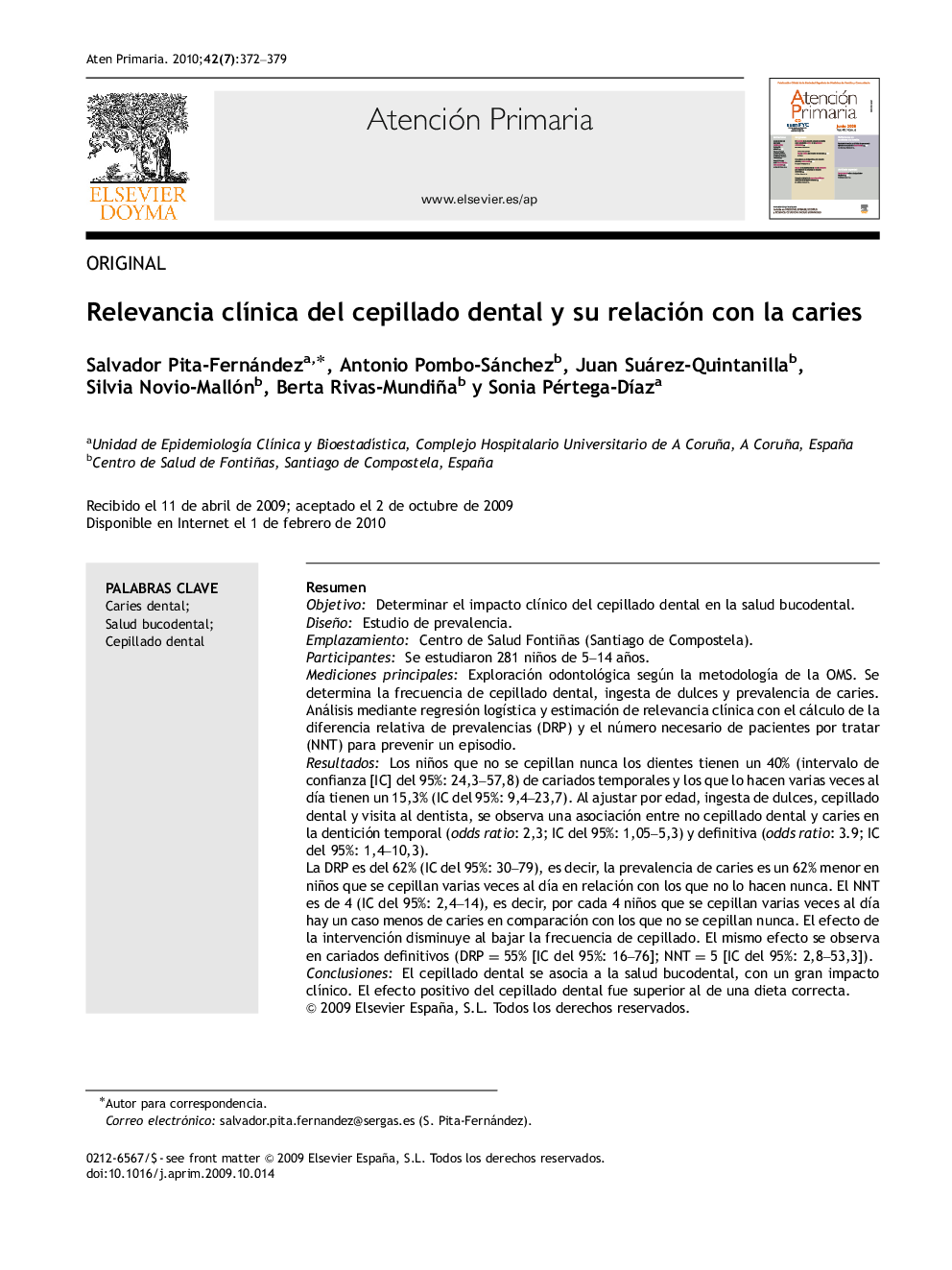| Article ID | Journal | Published Year | Pages | File Type |
|---|---|---|---|---|
| 3458214 | Atención Primaria | 2010 | 8 Pages |
ResumenObjetivoDeterminar el impacto clínico del cepillado dental en la salud bucodental.DiseñoEstudio de prevalencia.EmplazamientoCentro de Salud Fontiñas (Santiago de Compostela).ParticipantesSe estudiaron 281 niños de 5–14 años.Mediciones principalesExploración odontológica según la metodología de la OMS. Se determina la frecuencia de cepillado dental, ingesta de dulces y prevalencia de caries. Análisis mediante regresión logística y estimación de relevancia clínica con el cálculo de la diferencia relativa de prevalencias (DRP) y el número necesario de pacientes por tratar (NNT) para prevenir un episodio.ResultadosLos niños que no se cepillan nunca los dientes tienen un 40% (intervalo de confianza [IC] del 95%: 24,3–57,8) de cariados temporales y los que lo hacen varias veces al día tienen un 15,3% (IC del 95%: 9,4–23,7). Al ajustar por edad, ingesta de dulces, cepillado dental y visita al dentista, se observa una asociación entre no cepillado dental y caries en la dentición temporal (odds ratio: 2,3; IC del 95%: 1,05–5,3) y definitiva (odds ratio: 3.9; IC del 95%: 1,4–10,3).La DRP es del 62% (IC del 95%: 30–79), es decir, la prevalencia de caries es un 62% menor en niños que se cepillan varias veces al día en relación con los que no lo hacen nunca. El NNT es de 4 (IC del 95%: 2,4–14), es decir, por cada 4 niños que se cepillan varias veces al día hay un caso menos de caries en comparación con los que no se cepillan nunca. El efecto de la intervención disminuye al bajar la frecuencia de cepillado. El mismo efecto se observa en cariados definitivos (DRP=55% [IC del 95%: 16–76]; NNT=5 [IC del 95%: 2,8–53,3]).ConclusionesEl cepillado dental se asocia a la salud bucodental, con un gran impacto clínico. El efecto positivo del cepillado dental fue superior al de una dieta correcta.
AimTo determine the impact and clinical relevance of tooth brushing on oral health.DesignPrevalence study.LocationFontiñas Health Centre. (Santiago de Compostela, Spain). Prevalence study (n=281 children aged 5–14 years.Odontological examination according to WHO methodology, to determine the frequency of tooth brushing, frequency of sweet consumption and their impact on the prevalence of caries.Statistical analysisLogistic regression and estimation of the relative prevalence difference (RPD) and the Number Needed to Treat in order to prevent one additional bad outcome (NNT).ResultsThe children who never brush their teeth have a 40% (95% CI: 24.3%–57.8%) of early caries, while those who brush their teeth several times a day have 15.3% (95% CI: 9.4%–23.7%). An association between not brushing the teeth and caries in primary teeth (OR=2.3; 95% CI:1.05–5.3) was observed after adjusting for age, sweet consumption and visits to the dentist. The same occurred with final teeth (OR=3.9; 95% CI:1.4–10.3).The RPD was 62%(95% CI: 30%–79%), meaning that prevalence of caries is 62% lower in children who brush their teeth several times a day as compared to those who never brush their teeth. The NNT is 4 (95% CI: 2.4–14), so for every 4 children who brush their teeth several times a day, there is one less case of caries, compared to those who never brush their teeth. There is a dose-response relationship between prevalence of caries and brushing frequency. The same effect was observed with definitive caries: RPD=55% (95% CI:16%–76%), NNT=5 (95% CI:2.8–53.3).ConclusionsTooth brushing is related to oral health, with a major clinical impact. The positive effect of tooth brushing was superior to that of a correct diet.
